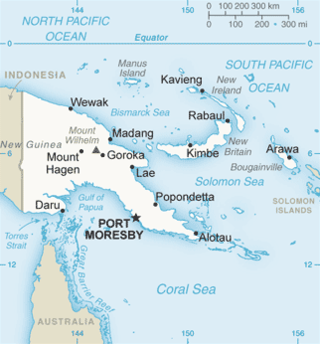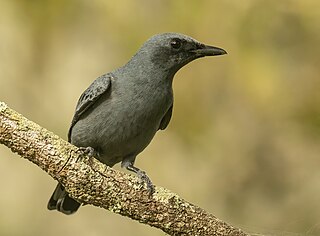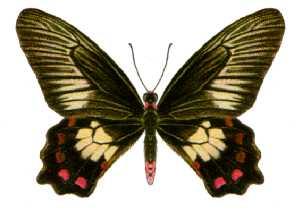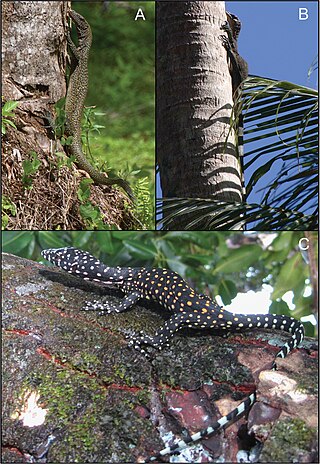
The geography of Papua New Guinea describes the eastern half of the island of New Guinea, the islands of New Ireland, New Britain and Bougainville, and smaller nearby islands. Together these make up the nation of Papua New Guinea in tropical Oceania, located in the western edge of the Pacific Ocean.

Emirau Island, also called Emira, is an island in the Bismarck Archipelago located at 1°38.5′S149°58.5′E. Emira is part of what on many maps are charted as the St Matthias Islands, also known as the Mussau Islands, a small group to the northwest of the main island group of New Ireland. Early explorers named it Squally Island, a name found in some early records. It is part of New Ireland Province, Papua New Guinea. The local language is a dialect of the Mussau-Emira language.
The Mussau-Emira language is spoken on the islands of Mussau and Emirau in the St Matthias Islands in the Bismarck Archipelago.

Rambutyo Island is one of the Admiralty Islands in the Bismarck Archipelago. Politically, Rambutyo Island is part of Manus Province, Papua New Guinea. The population (unknown) is concentrated on the west coast. Villages include Mouklen and Lengkau.

Ornithoptera goliath, the Goliath birdwing, is a birdwing butterfly found in New Guinea. It is the second largest butterfly in the world, after the Queen Alexandra's birdwing.

The St Matthias Islands are a small archipelago group of islands in the Bismarck Archipelago, in northern Papua New Guinea. They are within New Ireland Province.

The fauna of New Guinea comprises a large number of species of mammals, reptiles, birds, fish, invertebrates and amphibians.

Papua New Guinea together with the West Papua region of Indonesia make up a major tropical wilderness area that still contains 5% of the original and untouched tropical high-biodiversity terrestrial ecosystems. PNG in itself contains over 5% of the world's biodiversity in less than 1% of the world's total land area. The flora of New Guinea is unique because it has two sources of origin; the Gondwana flora from the south and flora with Asian origin from the west. As a result, New Guinea shares major family and genera with Australia and the East Asia, but is rich in local endemic species. The endemicity is a result of mountainous isolation, topographic and soil habitat heterogeneity, high forest disturbance rates and abundant aseasonal rainfall year round. PNG boasts some 15–21,000 higher plants, 3,000 species of orchids, 800 species of coral, 600 species of fish, 250 species of mammals and 760 species of birds and 8 species of tree-kangaroos out of which 84 genera of animals are endemic. Ecosystems range from lowland forests to montane forests, alpine flora down to coastal areas which contains some of the most extensive pristine mangrove areas in the world. Much of this biodiversity has remained intact for thousands of years because the ruggedness of the terrain made the interior lands inaccessible; furthermore low population density and restrictions on the effectiveness of traditional tools, ensured that these biodiversity was never overexploited.

The flora consists of many unique varieties of tropical plants. Blessed with a tropical climate and roughly 17,000 islands, Indonesia is the nation with the second highest biodiversity in the world. The flora of Indonesia reflects an intermingling of Asian, Australian and unique, Indonesian lineages. This is due to the geography of Indonesia, located between the aforementioned continents. The archipelago consists of a variety of regions, from the tropical rain forests of the northern lowlands and the seasonal forests of the southern lowlands through the hill and mountain vegetation, to subalpine shrub vegetation. With the second longest coastline in the world, Indonesia also has many swamps and other varieties of coastal vegetation. Combined, these all give rise to a huge floral biodiversity. There are about 28,000 species of flowering plants documented in Indonesia, including 2500 orchids, 122 species of bamboo, over 350 species of rattan and 400 species of Dipterocarpus, including ebony, sandalwood and teakwood. Indonesia is also home to some unusual species of carnivorous plants. One exceptional species is known as Rafflesia arnoldi, named after Sir Thomas Stamford Raffles and Dr. Thomas Arnold, who discovered the flower in the depths of Bengkulu, southwest Sumatra. This parasitic plant has the largest flower of any plant, does not produce leaves and grows only on one species of liana on the rainforest floor. Another unusual plant is Amorphophallus titanum from Sumatra. Numerous species of insect trapping pitcher plants can also be found in Borneo, Sumatra, and other islands of the Indonesian archipelago. There are a staggering 6000 traditional medicinal plants used as Jamu.,

Insect biodiversity accounts for a large proportion of all biodiversity on the planet—over half of the estimated 1.5 million organism species described are classified as insects.
The Bismarck trumpet-eared bat, also known as the Manus Island woolly bat, is a species of vesper bat in the family Vespertilionidae. It is found in subtropical or tropical dry forests.

The common cicadabird, also known as the slender-billed cicadabird, is a species of bird in the family Campephagidae. It is found in Australia, Indonesia, New Guinea, and the Solomon Islands. Its natural habitats are temperate forest and subtropical or tropical moist lowland forest. The species is placed in the reinstated genus Edolisoma by most authors. The common cicadabird was described as a "great speciator" by Mayr & Diamond (2001); and Pedersen et al. (2018) described how this species rapidly colonized and diversified across the Indo-Pacific island region and Australia in the Pleistocene.
The Mussau monarch, also known as the white-breasted monarch, is a species of bird in the family Monarchidae. It is endemic to the Bismarck Archipelago of Papua New Guinea. Its natural habitats are subtropical or tropical moist lowland forests and rural gardens. It is threatened by habitat loss.

The Admiralty flying fox is a species of fruit bat in the family Pteropodidae, the megabats. It is found in Papua New Guinea and the Solomon Islands.

The North Bismarck Plate is a small tectonic plate located in the Bismarck Sea off the northeast coast of New Guinea. It is currently regarded as a relic or inactive plate by most. At one time it was called the Manus Plate, but this term was later used for a modelled microplate at the south east boundary of the North Bismarck Plate.

Pachliopta polydorus, the red-bodied swallowtail, is a butterfly from the family Papilionidae found in north-eastern Queensland, Australia and Papua New Guinea.
The Kaijende Highlands are a nearly uninhabited expanse of mountains near Porgera in Enga Province, Papua New Guinea. The highlands have been characterized as "some of Papua New Guinea's most pristine and scenic montane habitat". The Kaijende Highlands include Lake Tawa, Paiela Road, Omyaka Creek, Waile Creek and the Porgera Reservoir. The mountain range is 70 km north-west of Mount Hagen. According to a survey conducted in 2007, "areas like Kaijende are characterized by pronounced dominance of microtherm families, most notably by Cunoniaceae, Epacridaceae, Ericaceae, Geraniaceae, Myrsinaceae, Podocarpaceae, Ranunculaceae, Rosaceae, Theaceae, Violaceae, and Winteraceae."

The West Melanesian Trench is an oceanic trench in the Bismarck Sea north of Papua New Guinea delineating the plate tectonic boundary between the Caroline and North Bismarck plates.

The Kilinailau Trench is an oceanic trench delineating the former oceanic crust boundary between the Pacific Plate and the now inactive North Bismarck Plate, in the area to the west of Papua New Guinea. To its south west is the inactive North Solomon Trench. The collision of the Ontong Java Plateau in the then subducting oceanic crust of the Pacific Plate, initially to the trench's south-east, changed the plate collision dynamics relative to the then Indo-Australian Plate to the west. Now the Ontong Java Plateau is just to the east of the trench and its great depth of crust appears to explain why subduction stalled here, and moved to the opposite direction along the far side of New Britain and the Solomons. The Melanesian ocean arc ridge structures formed when the trench was active are to its west and would include the north eastern part of New Ireland.

The Mussau Island blue-tailed monitor or Mussau monitor is a species of monitor lizard endemic to Mussau Island in Papua New Guinea. It belongs to the Varanus doreanus species complex.















